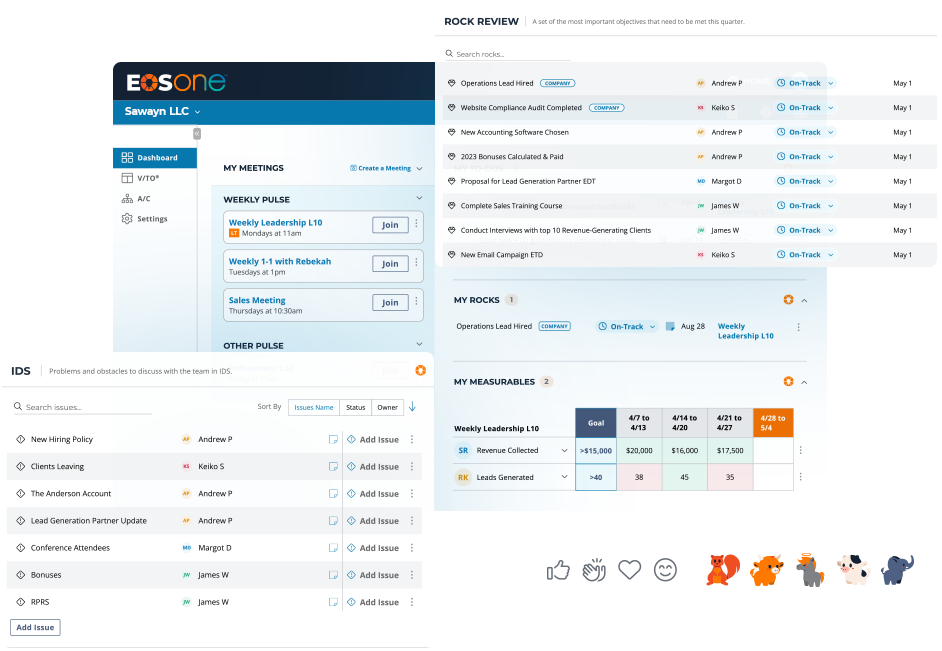“When you master the Data Component, you’ll be amazed at how in control of your business you can feel—and how in control you’ll actually be.”
Ever feel like you’re running your business in the dark—navigating growth, people, and profit with nothing but gut instinct and hope? That’s how most entrepreneurs start: passion-driven, moving fast and reacting even faster. But instinct alone doesn’t scale. And in the absence of real-time truth, it’s easy to veer off course.
The truth? Real leadership today means seeing the truth clearly, objectively, and in real-time. That’s why data isn’t just helpful. It’s the new currency of leadership.
In our book Data: Harness Your Numbers to Go from Uncertain to Unstoppable, we explain that data is the way to get out of the fog of uncertainty. Clear, timely, actionable data turns gut feelings into confident decisions.
We get it—data can sound cold or complex. Maybe you’ve thought: “We’re too small,” “Our numbers are a mess,” or “My team will hate this.” But those are myths. EOS® companies learn that just a handful of meaningful metrics create clarity, accountability, and real momentum.
Below is a straightforward, EOS-framed roadmap you can follow today to turn numbers into your organization’s most valuable currency.
Why Data Beats Gut Feel Every Time
Entrepreneurs love instincts, but instincts alone are unreliable. Psychologist Adam Grant calls intuition “a useful starting point, not a reliable ending point.” Our research inside thousands of EOS® companies shows five deep frustrations that surface when leaders rely on hunches:
| The 5 Frustrations | How Data Solves Them |
|---|---|
| Control – the business runs you | The Scorecard shows exactly where to focus |
| Profit – cash feels tight | Early financial metrics predict dips |
| People – mixed accountability | “Everyone Has a Number” culture |
| Hitting the Ceiling – stalled growth | Leading indicators reveal bottlenecks |
| Nothing Is Working – initiative fatigue | Consistent metrics replace |
Data empowers leaders to shift from reactive problem-solving to proactive innovation by eliminating uncertainty. This transformative ability inspires confidence and encourages innovation, which is why data has gained recognition as the new leadership currency.
The EOS Model: Where the Data Component Fits
The EOS Model has Six Key Components: Vision, People, Data, Issues, Process, and Traction. If you get the Data Component solid, every other component will become easier: you will see reality, solve issues faster, your people will know what winning looks like, and your processes will tighten.
Build a Scorecard that Works in the Real World
A Scorecard is “a handful of numbers that can tell you at a glance how your business is doing.” Follow these six steps to create yours:
- Identify 5–15 weekly metrics that predict success in every major function.
- Assign one owner per metric—clarity beats committee.
- Set a goal (or a tight range) for each number.
- Date the columns for the next 13 weeks to see trends, not snapshots.
- Appoint a scorekeeper who publishes the sheet before the weekly Level 10 Meeting.
- IDS every red number—treat misses like rumble-strip alerts, not background noise.
Resist the urge to overengineer. Your first version won’t be perfect; iterate. A good benchmark is whether you could survive on an island with nothing but this Scorecard delivered to you each week. Would you still know whether the company was healthy?
Related Reading: Download Our Free Scorecard Template
Everyone Has a Number—And Loves It
Complete mastery of the Data Component happens when every seat on the Accountability Chart has one meaningful, manageable number. Traction lists eight benefits, including clarity, competition, and faster problem-solving. People think a number will feel punitive, but most discover it’s the quickest path to autonomy because success is unambiguously defined.
Tips to roll this out:
- Cascade from the leadership Scorecard to departmental scorecards.
- Let the team propose their metrics first; refine together.
- Review numbers weekly, coach monthly, celebrate quarterly.
Case Study: Ironlink Logistics Moves from 80-Hour Weeks to Six Warehouses
Founder David Dembitzer once copied himself on every email to feel in control. After installing a Scorecard, he stopped micromanaging, opened four new warehouses, and finally took a real vacation—phone off. Why? Because weekly metrics told him overtime costs, response-time SLAs, and inventory turns were all on track.
Key takeaway: Data didn’t just grow revenue; it gave the Visionary his life back.
Practical Metrics to Start Tracking This Week
| Function | Leading Metric | Why It Matters |
|---|---|---|
| Marketing | Qualified leads added to CRM (goal: 8/week) | Fuels a predictable sales pipeline |
| Sales | Discovery calls completed (goal: 4/week) | Directly drives proposals issued |
| Operations | % of orders shipped within 72 hrs (goal: 95%+) | Protects customer experience |
| Finance | A/R over 60 days (goal: < 1% of revenue) | Keeps cash liquid |
| People | Score from Level 10 Meeting™ (goal: ≥8/10) | Early warning on culture |
Adopt one per department, refine, then layer on more.
Common Pitfalls and How to Avoid Them
- Measuring everything: if everything is a priority, nothing is. Stick to the vital few.
- Lagging indicators only: revenue booked is too late; track the actions that cause revenue.
- Weaponizing numbers: metrics expose issues, they don’t assign blame. Tackle the process, not people.
- Adjusting goals to look good: better to face the truth early than celebrate vanity metrics.
- Letting red go green without action: every miss gets an IDS and a to-do.
Your 30-Day Challenge
- Week 1 – Draft a Scorecard; pick one leading metric per function.
- Week 2 – Set goals and owners; publish before your next Level 10 Meeting.
- Week 3 – IDS every red cell; record to-dos and follow up.
- Week 4 – Hold a quick Scorecard retro: what’s useful, what’s noise, what’s missing? Update and repeat.
Do that for a quarter and you’ll start seeing around corners. Do it for a year and wonder how you led your team without it.
Leadership used to be about charisma and gut instinct. In today’s fast-moving entrepreneurial world, data is the new leadership currency. It buys clarity, speed, and peace of mind. More importantly, it buys back your time so you can think, create, and lead your team into the future.
Ready to trade chaos for clarity? Build your Scorecard, give everyone a number, and watch uncertainty become unstoppable momentum.





